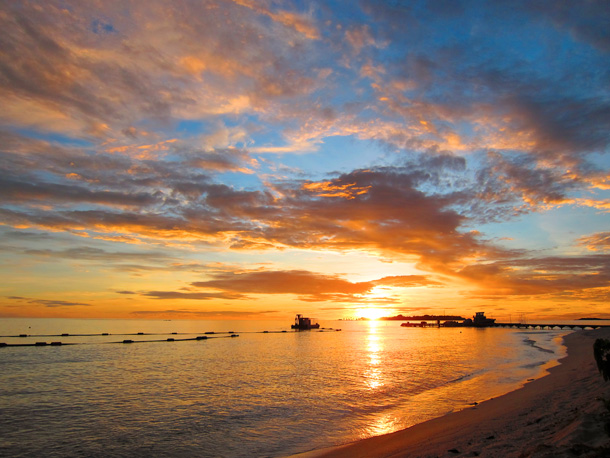
El Pilón de Azúcar at Cabo de La Vela. Photo: Eric Bauer
Oli Pritchard takes a journey to Cabo de la Vela and into La Guajira, South America’s northernmost region and discovers an isolated and rugged desert landscape
Temperature: 40°C. This is not so much hot as blistering… that’s what the car’s outside thermometer reads. Our car’s just blown out a tyre and, as the driver has waved us away from his repair job. Instead, we’re clambering through the brush to have a look at a stopped salt train. Who said there was nothing to do in Colombia’s harsh and foreboding tip, the Desierto de Alta Guajira?

Our intrepid reporter, through the shifting sands. Photo: Oli Pritchard
Amidst the plethora of snowcapped peaks, the miles of beaches, the layer upon layer of all types of forestation and the mighty rivers, it’s easy to forget that Colombia also boasts two deserts. Whilst Tatacoa is closer and more popular as a weekend trip from the gloomy grey capital, La Alta Guajira is by far the bigger and more interesting. This is wild west territory, miles of untouched virgin desert stretching into the distance. Like most remote areas of Colombia, indigenous people predominate. Indeed, when we change cars in the self-proclaimed “indigenous capital of Colombia”, Uribia, it feels more like India than Colombia, as 4x4s are loaded up far beyond any reasonable level and cows nonchalantly stroll through the maelstrom of cars and motos honking and shouting.

La Guajira Colombia. Photo: Wikipedia.com
But let’s rewind. We first arrived in the capital Riohacha, hungover and sweatier than a baker’s arse crack. After a slightly hairy wander through the part of town that looks like it’s not the bit you walk through in the dark, we washed up at the door of a Canadian hippy running a hotel in a former drug house. He cheerfully shows us the former safe where coke was kept before introducing us to the hotel dogs and providing us with much needed water. Riohacha’s probably no more than a quick stop to many people, but we quite liked it, replete as it was with places to get beer by the seafront. Walk out into the sea on a provincial pier, admire any one of the dozens of pillars that festoon the city and unwind a little.

Welcome to the capital of the north. Photo: Oli Pritchard
Despite the attractions of pillars, it’s time to get up to where we want to be, so we hotfoot it to a car which takes us up to Uribia. Depending on how jaded a traveller you are, it’s either bright and vibrant or rundown and dirty. Take your pick. From here, all your valuables are hurled on top of a 4×4, precariously juddering about as the jeep lurches into the desert. Inside the 4×4 is hotter than a toaster at max setting, but hanging out the back keeps you nice and cool, as well as affording much better views.

Cabo de La Vela, La Guajira. Photo: Jennifer Wang
Eventually, after stops at various houses and shacks that pop out of nowhere like wooden oases, massive walls of plastic bags caught in shrubbery tell us we’re heading into a population centre – the 1000 or so people of Cabo de La Vela. Better to look one way than the other in La Guajira, it would seem. That said, there’s plenty of time to organise hammocks for the night before a sundown juice gazing at the sea. Life in Cabo doesn’t go on late into the night, but a pack of cards will pass the time, and beer’s easier to find than fresh water, which can’t be bad, unless you’re Paul Merson. Just be aware that many places require a meal order hours in advance, so don’t expect much if you wander back into town around seven. You’ll be snoozing under the spectacular array of stars earlier rather than later.

Northernmost point of the continent, Punta Gallinas. Photo: Oli Pritchard
There are tours-a-plenty going off to various beaches and sites, but being obstinate tightwads/rugged individualists, we walk straight off across the desert plains towards the beach. You can’t miss it, just walk towards the pyramid-like hill. It’s hot and the sun is fiercer than a lion in a dole queue, but you need only march a little more than an hour, and it’s a lot of fun. As you traipse over the last of the dunes, you’re rewarded with a beautiful crescent beach with cool, safe water to muck about in. There’s also a statue of Mary to climb up to on the Pilón de Azucar, which is nothing like a pylon and simply a hill on the side of the beach. The same sense of laughable over-description applies to the Ojo de Sal, a sorry mess of stagnant water. Maybe spectacular on its day, but not today. The lighthouse next door isn’t much to write home about either, although that’s exactly what I’m doing now and the sunset views are fairly impressive – any tourists wanting to tick boxes and take clichéd photos might as well piss off down the coast to Tayrona or Cartagena. The glory of La Guajira has to be seen in the round, as a whole. If running around on cliffs and jumping through cactuses sounds more like a pain than an adventure, this might not be for you.

Miles of nothing, dunes and more dunes. Photo: Azzam Alkadhi
Nice as it is at Cabo, the real and literal high point of La Alta Guajira is at Punta Gallinas, the northernmost point in all of South America. It’s neither particularly easy nor cheap to get to, but well worth the journey. The signs of human habitation drop yet further away as you push on north through the blasted desert wastelands to an abandoned beach. After a period of gazing at seemingly endless sea, a boat arrives to transport us on to a little finca sort of thing. There’s not much up here, but after a typically awful coffee, we are herded like those cute and tasty goats onto a van towards the tip of the continent.

One of the many spectacular sunsets in La Guajira. Photo: Azzam Alkadhi
After the tip of the continent come the sand dunes, and we clamber right to the top like good little tourists, before hurtling down in a mess of flailing arms and legs, even unto the sea, who receives us in her open arms. Next, it’s a trek back up to the top of the dune and home for more fish and cards before a cold water shower and retiring to the hammocks.

The waterfront at Cabo de La Vela. Photo: Azzam Alkadhi
The order of the day in La Guajira is definitely seafood, especially lobster at jaw-droppingly low prices. COP$30,000 buys you a whole beast, split open quicker than an Essex girl’s legs and cooked twice as nicely. Strangely, most cooks won’t crack the claws for you, though without any rush to get things done, you can leisurely break into the juicy meat below if you wish. Although not as big as the coldwater lobsters in yankee doodle land, they’re an absolute steal and still tastier than anything walking on land. Of the beasts that walk upon the ground, goats are the big draw. Sadly, we are gravely informed by various people that the goats aren’t yet ready to be butchered for our plates. A pity for this writer, who could quite happily eat a whole goat from horn to tail, but returning around Christmas might bring more joy. [Ed.: I was lucky enough to be around in goat season and I find myself having regular cravings for Guajiran goat meat. Sorry Oli.]

The basic living conditions of Punta de Gallinas. Photo: Azzam Alkadhi
Tourist amenities in La Guajira are odd. There are a few places set up to receive 4x4s, many tripping over from Venezuela, but generally speaking, in the Alta Guajira, things are very rustic. Water isn’t always available everywhere, and with severe drought problems, you’d do well to consider how much water you actually need to use. You’d have to be a right muppet to piss water up the wall out here. The sea will function as a reasonable bathing spot if necessary.

Riohacha, more to see than just pillars! Photo: Oli Pritchard
If it’s four star luxury you crave, this is not the place to be. If it’s the four thousand stars in the sky above your basic hammock that get your juices flowing, this is the back to basics travelling adventure you’ve dreamt of. It’s nowhere near that basic, but it’ll impress your family when you get home to pontificate off on such things.
There’s plenty of adventures to be had in Colombia, but this is one unlike any of the others, almost un-Colombian in many ways. Stick on the Queens of the Stone Age and get out to the desert with some cheap tequila and fat cigars. You won’t regret it.





